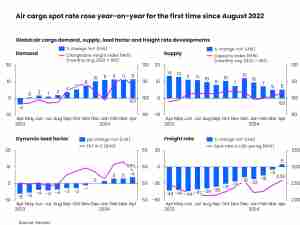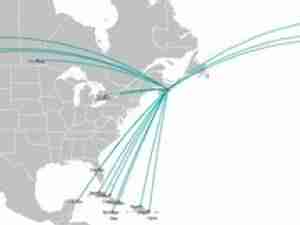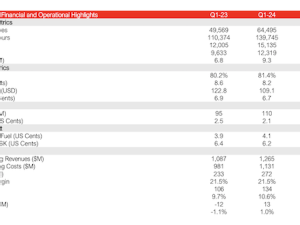IBA, the leading aviation market intelligence and consulting company, has today published its latest monthly Aviation Carbon Emissions Index in association with KPMG. This month’s index also includes a spotlight on the most efficient airlines globally by region.
Aviation carbon emissions intelligence from IBA NetZero has revealed that CO2 emissions from commercial aviation averaged 141.9 grams of CO2 per-seat per-mile in August 2022, and that overall carbon intensity per-seat remained unchanged compared to the previous month. This represents a 1.2% reduction in CO2 intensity per-seat per-mile year-on-year, maintaining record lows for the industry.

What Happened to Global Aviation in August 2022?
Whilst August presented little change month-on-month, year-on-year increases are more noteworthy, especially when considering the almost 30% increase in flights compared to August 2021. This is only 17% below pre-pandemic levels in August 2019.
Air Canada issued its first TCFD report on August 17th, reaffirming the flag carrier’s strong focus on reaching net zero by 2050 through acceleration of SAF production in Canada, carbon offsetting and fleet and operational improvements. Similarly, Cebu Pacific reaffirmed its sustainability commitments and announced the introduction of SAF, a plan for an ‘all neo’ fleet, and resource optimisation. Elsewhere, Neste and Hellenic entered agreements to begin SAF production for Aegean Airlines in Greece, with Neste planning to increase its SAF production to 1.5 million tonnes by the end of 2023.
Commenting on developments, Chris Brown, Partner and Head of Strategy in Ireland, KPMG says:
“With the new rise in jet fuel prices, airlines are again under pressure as they head into the low season. This pressure is further increased with demands on airlines to reduce the CO2 emissions and the cost of SAF. We are not surprised by Airbus' announcement about a partnership between airlines and airline groups. This partnership will comprise more than a dozen worldwide carriers working together on a new carbon capture project, intending to provide secure, verifiable carbon removal credits as part of aviation's need to offset part of its future emissions.
“As airlines are struggling with the fluctuations in fuel, demand, and the rising cost of carbon, we see this as a necessary step airlines need to take to control costs in the long term. Notably, Covid-19 has given some new airlines, such as Norse Atlantic, access to the latest technology and more fuel-efficient aircraft.
“Our strategy has extensively modelled decarbonisation options for aviation and still leaves the sector with a 30-40% shortfall to 2050 net zero. That will translate into a lot of offsets – arguably more than there currently are in terms of the total global supply of quality nature-based sequestration initiatives. Direct Air Carbon Capture, therefore, takes on real significance to the sector.”
Aircraft Efficiency Spotlight
The aircraft type with the largest share of global emissions is driven by utilisation trends and fleet size. August 2022 saw little change in these trends, and, as such, IBA’s aircraft efficiency ranking shows little movement this month. Whilst the Boeing 737-800 retains its position with the highest emissions share, it is important to highlight that it saw a monthly decrease of 0.3% in total emissions share. Whereas, the 777-300ER has seen an increase of 0.4%, the largest increase amongst the most popular aircraft types. It can also be noted that the general trend of a decrease in proportional emissions for these popular types continues, primarily driven by the increase in use of the A321-200NX and 737 MAX 8.
The largest operators of the A321-200neo by emissions share are IndiGo and American Airlines, with 13.4% and 13.2% of global emissions respectively. Amongst A321-200neo high emitter operators, Wizz Air has seen the largest surge month-on-month with a 13.7% increase in carbon emissions. This will only continue to accelerate with an order book standing at 248 in August 2022.

Airline Efficiency Spotlight
Whilst Wizz Air Abu Dhabi achieved the lowest CO2 emissions per-seat per-mile in August, both Lynx Air (last month’s new addition) and French Bee (last month’s top performer) maintain their presence in IBA’s top 5. Neos and Scoot exited the ranking this month and were replaced by two airlines that were established in 2021. The first, World 2 Fly headquartered in Spain operates two A350-900 aircraft. These have an average age of 0.9 years and feature a high seating density, with 432 seats against the more typical 283 seats. Re-joining IBA’s ranking this month, Norse Atlantic Airways utilises six Boeing 787-9 aircraft, which are on average four years old. These contain 344 seats.

Lessor Efficiency Spotlight
There was little change in the balance of CO2 emissions from lessors in August 2022, with a 0.2% decrease observed from 127.7 to 127.5 grams of CO2 per-seat per-mile. Jackson Square Aviation remains at the top of IBA’s lessor efficiency index in August, as it has consistently done in recent months. Of the top 10 lessors, AerCap still dwarves the others, with its relative share of emissions to the overall industry north of 6% and the next largest emitter being Air Lease Corporation at less than 2% of overall emissions.
The proportion of emissions from the top 10 lessors to the industry has also decreased since the start of 2022 to August from approximately 19.3% to 16.6%. This is interesting as both the industry average and the top 10 lessors have had an approximate 1% decrease in CO2 per-seat per-mile. This suggests that the largest lessors are becoming more efficient than the industry average on a sector length basis, or that a broader diversity of lessors is emerging. Indeed, the leasing industry has seen an increase by circa 30% in total emissions year-to-date, suggesting a larger portion of lessor-owned aircraft operating in the market.

Monthly Spotlight: The Most Efficient Global Airlines


IBA NetZero reveals that Sunwing was the most efficient airline per-seat per-mile in North America in August 2022. They operate six 737 MAX 8s and five 737-800s with an average age of 3.2 and 10.8 years respectively. Both have 189 seats, versus a more typical 162. 60% of Sunwing’s emissions in August can be attributed to the new generation Boeing 737 MAX 8 aircraft. Sunwing mainly operates sectors on the east coast, from South East Canada to the Gulf of Mexico and the Caribbean. Their average sector length was 1380 Nautical miles.
In Africa, Air Seychelles tops IBA’s ranking. They operated just two Airbus A320neo aircraft in August, which were 2.9 years old according to fleet data from IBA Insight. These aircraft have 168 seats, which is actually lower than the more typical 189 seat configuration. Whilst this should be a disadvantage when measuring emissions per-seat, it is countered by the operator’s near-ideal sector length of 1843 nautical miles. This is close to the ideal efficient distance for narrowbody fuel burn, and higher than most other African operators.
Hong Kong Express Airways tops IBA’s efficiency ranking in the APAC region in August, producing 100.98 grams of CO2 per-seat per-mile. The operator’s fleet consists of 26 aircraft, including five A320-200s, ten A320-200neos and eleven A321-200s with average ages of 10.4 years, 3.7 years and 4.9 years respectively. Only the Airbus A320neo fleet was operated in August. This has been the driving force in placing Hong Kong Express at the top of IBA’s ranking. Despite having shorter sectors and a fairly typical seating configuration, their exclusive use of new generation aircraft in this period produced the lowest figure.
In the Europe & CIS region, French Bee was the most efficient airline based on CO2 emissions per-seat per-mile. French Bee appears regularly in IBA’s rankings and was the most efficient global airline in IBA’s July 2022 index. They exclusively operate young, new generation Airbus widebodies of the A350 family. The seating density of the French Bee fleet is also notably above average, with the A350-900s at 411 seats and the A350-1000 at 480 seats (versus the more typical 283 and 366 respectively). They operated sectors from Paris to La Reunion, New York and the west coast of the United States, with an average sector length of 4470 Nautical Miles (the longest of IBA’s top 5 by a clear margin). French Bee has all the driving factors to be the relative lowest emitter per-seat per-mile in Europe & CIS, with its dense seat configuration, sole use of wide-bodies coupled with long average sector length and young fleet.
In Latin America, the most efficient airline in August was Arajet, an ultra low-cost start up. They operate five Boeing 737 MAX 8 aircraft with an average age of 0.4 years. The seating capacity of these narrow-bodies are above their typical capacity, at 185 seats versus the more typical 162. In August, they operated two flights from the Dominican Republic to Bogota and Guatemala, and are anticipated to ramp up activity in September 2022. Arajet’s average sector length was 1042 Nautical Miles, the longest of the top 5 with the exception of Air Caraibes, which solely operates widebodies. Whilst Arajet was the lowest relative emitter per seat per mile in Latin America in August 2022, this is largely due to its brand new fleet with high seat density and low number of flights. IBA will monitor any changes in their performance as activity increases.
In the Middle East region, the most efficient airline on a CO2 per-mile basis in August was Wizz Air Abu Dhabi. They operate five aircraft including, four A321-200neos and one A320-200, with average ages of 1.9 years and 17.2 years respectively. In August, more than 85% of their emissions can be attributed to the A321-200neo fleet. The seating layout of the A321-200neos is quite dense, with their capacity of 239 seats versus a more typical capacity of 194. Their older A320-200 aircraft have 180 seats, just above the more typical 178. They operated from Abu Dhabi to Egypt, the Balkans and the south Caucasian region (Armenia, Azerbaijan and Georgia). Wizz Air Abu Dhabi’s average sector length was 1070 Nautical Miles, which is fairly average amongst the top 5, all of which only operated narrowbodies in August.















